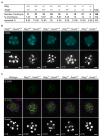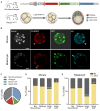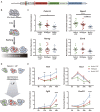Transitions in cell potency during early mouse development are driven by Notch
- PMID: 30958266
- PMCID: PMC6486152
- DOI: 10.7554/eLife.42930
Transitions in cell potency during early mouse development are driven by Notch
Abstract
The Notch signalling pathway plays fundamental roles in diverse developmental processes in metazoans, where it is important in driving cell fate and directing differentiation of various cell types. However, we still have limited knowledge about the role of Notch in early preimplantation stages of mammalian development, or how it interacts with other signalling pathways active at these stages such as Hippo. By using genetic and pharmacological tools in vivo, together with image analysis of single embryos and pluripotent cell culture, we have found that Notch is active from the 4-cell stage. Transcriptomic analysis in single morula identified novel Notch targets, such as early naïve pluripotency markers or transcriptional repressors such as TLE4. Our results reveal a previously undescribed role for Notch in driving transitions during the gradual loss of potency that takes place in the early mouse embryo prior to the first lineage decisions.
Keywords: Cdx2; chromosomes; developmental biology; gene expression; morula; mouse; notch; preimplantation development; trophectoderm.
© 2019, Menchero et al.
Conflict of interest statement
SM, IR, AL, MA, JS, MK, JA, RB, TR, AH, MM No competing interests declared
Figures

























References
-
- Behringer R, Gertsenstein M, Vintersten Nagy K, Nagy A. Manipulating the Mouse Embryo: A Laboratory Manual. Fourth edn. New York: John Inglis; 2014.
Publication types
MeSH terms
Substances
Associated data
- Actions
- Actions
Grants and funding
LinkOut - more resources
Full Text Sources
Molecular Biology Databases

